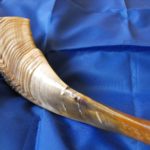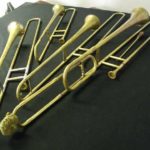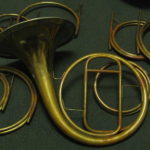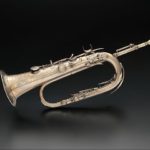1 A Brief History of Brass Instruments
Significant portions of this chapter were adapted from Steven Maxwell’s Teaching Low Brass, accessed at http://newprairiepress.org/ebooks/22 under a Creative Commons license 4.0.
It is important to understand the history of brass instruments as an educator for a few reasons. First, students will come to you with questions and strange instruments from the back of closets, and a basic understanding of history will allow you to better respond to the gnarled family tree that makes up brass instruments. Second, the history of an instrument will help you to understand the musical role of the instrument and why it functions as it does in various ensembles today. Third, learning the history of brass assists you with understanding the technical and physical limitations and advantages of the instrument. Finally, knowing the history of an instrument helps you to understand the literature that is available for the instrument.

Early brass instruments were made from hollow items found in nature such as termite hollowed eucalyptus or conch shells. Thousands of years ago, straight and curved trumpets were constructed of a variety of materials including wood, bronze, and silver, such as the Greek salpinx and the Roman tuba, lituus, and buccina. Other early brass instruments were flared horns made of bronze or animal horn, like the Scandinavian lur, the Roman cornu, and the Hebrew shofar (which is still used in Jewish ceremonies today).
1400-1600

During the Renaissance, brass instruments began to develop into the instruments we know and recognize today. The earliest known curved trumpets were developed in the early 15th century, which was followed by the folded and slide trumpets. These early instruments had wide interval spacing between notes due to their acoustic characteristics (which still influence brass instruments today). The trombone developed out of the slide trumpet around 1450, referred to as the sackbut. While structurally different from the modern trombone, the sackbut revolutionized brass instruments by allowing for chromatic performance. It also allowed for the development of an instrument with a practical tenor range, which developed into the modern trombone today.
During this period, the trumpet and horn existed, but they were considered functional, non-musical instruments. European courts maintained corps of trumpeters used for signal heralding. These ensembles involved up to five-part music, but were limited in their harmonic variety due to the construction of the non-chromatic instruments. Players tended to specialize in high or low register, and music with artistic merit for brass was scarce. The horn existed at this time as well, typically used for hunting to allow for communication over distances outside. The horn began to be presented at this time in its curved and helical design.
By the end of the 1500s, brass instruments (particularly the sackbut) began to be used within both like instrument and mixed ensembles. In 1597 Italian composer Giovanni Gabrieli, then the organist at Saith Mark’s Cathedral in Venice, composed the earliest known piece to call for specific brass instruments, Sonate pian’forte.
1600-1750
Brass instruments began to be used more extensively in the 17th century as ensemble instruments. Many of the instruments were used in outdoor performances or as a supportive voice in church choirs. Brass instruments had little use as solo instruments. During this time, brass instruments could play chromatic passages through use of the high overtone series (which can be quite difficult to perform) and through the use of ‘stopped’ notes on horn.
Sackbuts were regularly employed in a variety of ensembles, such as court and municipal bands, where it was common to combine them with double reed shawms. The sackbut was also used in ensembles where they were to blend with softer instruments or voice to improve projection. A vocal-like style of playing developed for the trombone that contrasted the period’s fanfare trumpet style. By the mid-18th century, solo pieces for alto trombone were written by Christoph Wagenseil, Johann Albrechtsberger, Michael Haydn, and Leopold Mozart. With the sacred associations of the trombone from the previous century it was natural for composers to utilize trombones to help portray religious or supernatural effects in operas of the late 18th century. Two of the most easily recognizable examples of this were in Wolfgang Amadeus Mozart’s Don Giovanni and The Magic Flute.

During the 18th century, the horn developed as an instrument capable of musical expression, rather than as a utilitarian or novelty instrument. A Viennese instrument maker, Michael Leichnambschneider, began to put terminal crooks on horns in order to play them in different keys around 1700. In 1705, Reinhard Keiser added the horn to his orchestra for the first time in his opera, Octavia, and Georg Frederic Handel added two horns to Water Music in 1717. The horn played mostly in its upper overtone series to allow for diatonic movement. Around 1750, a hornist in Dresden, Germany developed techniques for hand stopping that allowed for chromatic playing of the horn in the lower register, and this soon became a standard practice for horn players. The first major horn concerto was written by Franz Joseph Haydn using this chromatic practice in 1762.
The trumpet developed as a virtuosic instrument during the first half of the 18th century, reaching its peak in the compositions of Johann Sebastian Bach, originally written for trumpet virtuoso Gottgried Reiche. This clarino technique used the extreme upper register of the trumpet, often in a soloistic capacity. By the second half of the 18th century, tastes for this technique changed, leading to a decline in the virtuosic presentation of the trumpet in ensemble music during the Classical period.
1750-today
The 19th century was the period of greatest development and modernization of brass instruments. The vast majority of literature for brass instruments performed today was written from the late 19th century through today. This is largely due to developments in brass instruments starting in the late 1700s that allowed for greater ease of chromatic manipulation and expressive performance. By the Classical period, trumpet and horn were standard fixtures of the orchestra with trombone and tuba following in the 1800s.

The keyed trumpet was developed by Viennese trumpeter, Anton Weidinger, to allow for chromatic performance on trumpet around 1770. While this instrument was short lived due to problems in tone consistency, it opened the possibility of the trumpet to be used as a chromatic solo instrument, leading to its first major concertos by Franz Joseph Haydn in 1796 and Johann Nepomuk Hummel in 1803. In 1818, the first horn rotor was patented by Heirich Stölzel and Friedrich Blümel in Germany, and around 1826, German instrument makers began producing valved trumpets. The development of rotors and valves made instruments far superior to hand stopped or keyed versions of brass instruments due to their consistency and dexterity, and were quickly adopted by composers. Hector Berlioz was the first to use these new instruments in his Overture to Les Francs-juges in 1826, followed by the use of valved horns in Fromental Halévy’s opera, Le Juive. By 1835, the first tuba, pitched in F with five valves, was invented by Berlin instrument makers Wilhelm Wieprecht and Johann Gottfried Moritz, followed by the earliest euphonium in 1843 by Sommer of Weimar.
Throughout the 20th century, many variations on the standard brass instruments have been made. Numerous keys of trumpets have been created, including the Bb, C, Eb, and piccolo trumpet. Each of these alter the timbre of the instrument and provide various advantages to the performer. The horn has added a second “side,” allowing the same instrument to play in F and Bb. The double horn, as it is termed, allows for greater flexibility and precision in performance. The trombone frequently includes an F attachment, which is similar to the Bb side of the horn to allow for greater ease in performance with less slide movement. The euphonium and tuba continued to be developed throughout the 20th century by including various configurations, notably including 4th and 5th valves or rotors that provide for greater ease in pitch manipulation and dexterity.
Various instruments have come and gone throughout this time period as well. These include novelty instruments such as the double-belled euphonium, alternatives to modern instruments such as the saxhorn, and various bass instruments including ophicleides.
With better designed instruments and the development of musicians with increased technical and musical ability, trumpet, horn, trombone, and tuba became standard parts of the orchestra with increased exposure within the large ensemble and numerous solo works. At the same time, the concert band developed with the brass section playing a significant role with the inclusions of sections of trumpets, cornets, horns, trombones, euphonium/baritones, and tubas.

